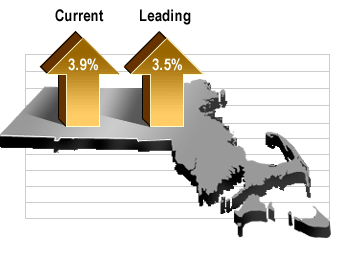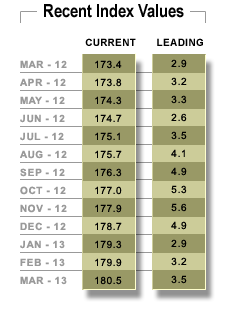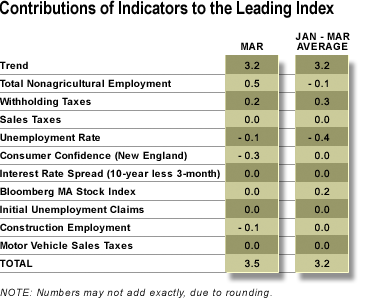The Bay State grows solidly in the first quarter, UMass journal reports
Federal sequestration spending cuts and weak international conditions weigh on economic growth prospects.
March 2013
 Massachusetts real gross state product grew at an annual rate of 3.9 percent in the first quarter of 2013 according to the latest MassBenchmarks Current Economic Index released today by MassBenchmarks, the journal of the Massachusetts economy published by the UMass Donahue Institute in collaboration with the Federal Reserve Bank of Boston.
Massachusetts real gross state product grew at an annual rate of 3.9 percent in the first quarter of 2013 according to the latest MassBenchmarks Current Economic Index released today by MassBenchmarks, the journal of the Massachusetts economy published by the UMass Donahue Institute in collaboration with the Federal Reserve Bank of Boston.
In contrast, U.S. real gross domestic product grew at an annual rate of 2.5 percent during the same period. In the fourth quarter 2012, we now estimate that real gross domestic product in Massachusetts grew at an annual rate of 2.4 percent, while the U.S. grew by just 0.4 percent.
By any of the fundamental measures of economic growth — employment, income, and spending — the Massachusetts economy had an excellent first quarter. Payroll employment in the first three months of 2013 grew at a 2.9 percent annual rate and wage and salary income (as estimated from state withholding taxes) grew at a stunning 19.9 percent annual rate during the same period. A significant portion of this income growth was likely due to sizeable bonus payments made to workers in the state's financial and professional services sectors. Spending on items subject to regular and motor vehicles sales taxes was also robust in the first quarter, growing at an annual rate of 11.6 percent.
 This burst of recent growth is unlikely to be repeated in the second quarter. The state economy appeared to slow significantly in March with a decline in payroll employment and weaker than expected withholding and sales tax revenues.
This burst of recent growth is unlikely to be repeated in the second quarter. The state economy appeared to slow significantly in March with a decline in payroll employment and weaker than expected withholding and sales tax revenues.
The MassBenchmarks Leading Economic Index for March was 3.5 percent, and the three-month average for January through March was 3.2 percent. The leading index is a forecast of the growth in the current index over the next six months, expressed at an annual rate. Thus, it indicates that the state economy is expected to grow at an annualized rate of 3.5 percent over the next six months (through September 2013).
"The national and state economies are being strongly influenced by two opposing forces," noted Dr. Alan Clayton-Matthews, MassBenchmarks Senior Contributing Editor and Associate Professor of Economics and Public Policy at Northeastern University, who compiles and analyzes the Current and Leading indices. "On the one hand, growth in consumer demand is being supported by rising home prices, stock markets and job expansion. On the other hand, fiscal drag in the form of the payroll tax increase and federal budget cuts are slowing the economy. This fiscal drag could dampen growth by as much as 1.5 to 2.0 percentage points this year. And the continuing recession in Europe and an apparent slowdown in China are not helping matters." Clayton-Matthews added.
The effects of budget sequestration can already be seen in the number of jobs in the state's scientific research and development sector, which is heavily influenced by federal grant spending in health and science. Employment levels in this key sector were lower at the end of the first quarter than last December. This is striking as this industry had been adding jobs at a relatively rapid pace throughout the recession and the recovery.
Opposing the negative effects of federal fiscal policy and weak international conditions is solid growth in consumer spending fueled by steady job growth, a strong stock market, and rising home prices. At this point in time, this positive force is more than counterbalancing the aforementioned negative forces.
While the Commonwealth continues to recover, the federal budget sequestration continues to slow the Commonwealth's leading industries — including health care, higher education, and research and development. Consequently, slower growth in Massachusetts can be expected over the next two quarters.
 The 10 indicators that comprise the leading index usually do not all move in tandem. Typically, some may indicate an expectation of faster than average growth, while at the same time others may indicate an expectation of slower than average growth. The following table accounts for the contributions of each towards faster or slower growth than the long-term trend of 3.2 percent. The index value is their sum.
The 10 indicators that comprise the leading index usually do not all move in tandem. Typically, some may indicate an expectation of faster than average growth, while at the same time others may indicate an expectation of slower than average growth. The following table accounts for the contributions of each towards faster or slower growth than the long-term trend of 3.2 percent. The index value is their sum.
In March, two indicators contributed to a forecast of above-trend growth: total nonagricultural employment, and withholding taxes. Three indicators contributed to below-trend growth: the unemployment rate, consumer confidence, and construction employment. Five indicators contributed to average-trend growth: sales taxes, the interest rate spread between 10‑year and 3‑month U.S. Treasury securities, the Bloomberg stock index for Massachusetts, initial unemployment claims, and motor vehicle sales taxes.
In the three-month period January through March, two indicators contributed to a forecast of above-trend growth: withholding taxes, and the Bloomberg stock index for Massachusetts. Two indicators contributed to below-trend growth: total nonagricultural employment, and the unemployment rate. Six indicators contributed to average-trend growth: sales taxes, consumer confidence, the interest rate spread between 10‑year and 3‑month U.S. Treasury securities, initial unemployment claims, construction employment, and motor vehicle sales taxes.
The current and historical quarterly estimates for state domestic product growth include adjustments for changes in productivity growth. These adjustments are estimates of the quarterly deviations from trend in the growth of the ratio of output to employment and output to wage and salary income. In the first quarter, these adjustments subtracted 0.8 percentage points from the annual rate of growth. In the fourth quarter of last year, these adjustments subtracted 2.5 percentage points from the annual rate of growth. For the forecast of state domestic product growth for the second and third quarters of this year, productivity growth is assumed to return to its long-term trend. The methodology and rationale for these adjustments are available from the author upon request.
Several recent months of the indices are revised each release. These revisions are a result of the statistical method used to create the index, as well as revisions in the underlying indicators.
--------
All of the indicators except interest rates refer to Massachusetts. The current index is composed of four indicators: nonagricultural employment, withholding taxes, sales taxes, and the unemployment rate. The leading index includes these four current indicators plus the other six (leading) indicators in the contributions table. All of the indicators are as of March, except for interest rates, and the Bloomberg stock index for Massachusetts, which are through April 22. The MassInsight Consumer Confidence Index is released every third month. Intervening months are interpolated, and changes in the Conference Board's Consumer Confidence Index for the U.S. are used to extrapolate to the current month of the index, as needed. Series measured in dollars, i.e., withholding taxes, sales taxes, the Bloomberg stock index, and motor vehicle sales taxes, are deflated by the U.S. consumer price index for all urban consumers, excluding food and energy.
For a description of the methodology used to construct these indices, see: Alan Clayton-Matthews and James H. Stock, "An application of the Stock/Watson index methodology to the Massachusetts economy," Journal of Economic and Social Measurement, vol. 25 (1998/1999), pp. 183-233.
Dr. Alan Clayton-Matthews
MassBenchmarks
Northeastern University, School of Public Policy and Urban Affairs
April 26, 2013

